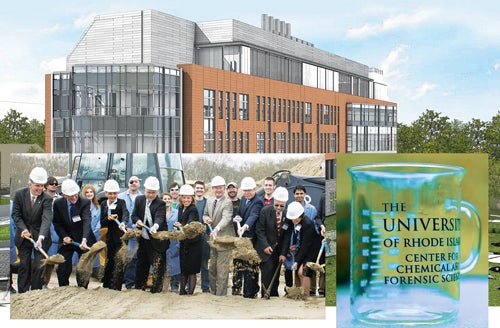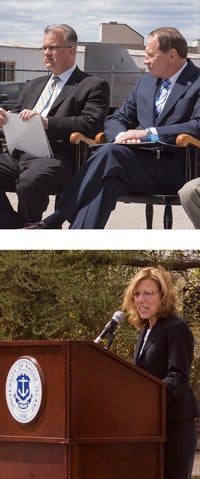New Center for Chemical and Forensic Sciences

In May, the University of Rhode Island held a ceremonial groundbreaking to celebrate the early phase of construction on a $68 million Center for Chemical and Forensic Sciences, a key component in strengthening the University’s leadership position in the health and life sciences and to building the state’s knowledge economy.
 Funded in large part by a $61 million bond issue approved by Rhode Island voters in the 2010 election, the center will serve more than 7,000 chemistry students. About 40 percent of all URI degree programs require at least one chemistry class.
Funded in large part by a $61 million bond issue approved by Rhode Island voters in the 2010 election, the center will serve more than 7,000 chemistry students. About 40 percent of all URI degree programs require at least one chemistry class.
The 135,000-square-foot Center for Chemical and Forensic Sciences will replace Pastore Hall, which was built in 1953 to accommodate 800 students. The Center will triple the amount of existing space for teaching labs and nearly double the space for research labs. It will provide state-of-the-art facilities for leading faculty who conduct research in such areas as developing advanced batteries to fuel energy efficient automobiles, improving resolution in magnetic resonance imaging (MRI) scans, and creating new clinical methods for earlier disease detection. And it will house one of the nation’s key resources for research and training in the battle against terrorism, the U.S. Department of Homeland Security’s Center of Excellence for Explosives Detection, Mitigation and Response.
“We express our gratitude to the people of Rhode Island for having the foresight to support a project that is directly related to the kind of economy we are building in the state,” URI President David M. Dooley said. “This facility will be a cornerstone of discovery, innovation and in turn economic vitality.”
Chemistry is the foundation of many research and teaching endeavors, as well as future jobs in health sciences, biotechnology, energy, the environment, pharmacy, nursing and high technology.
The Center will stand between the Chafee Social Science Center and White Hall, near the Center for Biotechnology and Life Sciences and the College of Pharmacy Building, completing the Health and Life Science District on the Kingston Campus’s northern sector.
The project is expected to create about 1,200 jobs in construction, trades, architecture, engineering, management, teaching and research.
 Home
Home Browse
Browse Close
Close Events
Events Maps
Maps Email
Email Brightspace
Brightspace eCampus
eCampus


